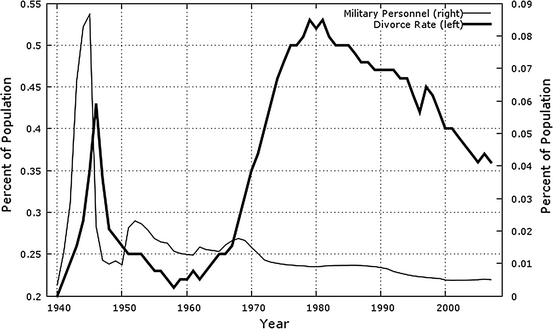Military Divorce Rate vs. Civilians
Contents
- Military Divorce Rate vs. Civilians
- The Numbers Tell the Real Story about Divorce
- Military life and stressors that contribute to divorce
- Professions with the Highest Divorce Rates
- Resources available to military couples
- FAQs about Military Divorce Rates
- What is the average divorce rate in the military?
- What military base has the highest divorce rate?
- Why is divorce so common in the military?
- What is the 10 10 rule for military divorce?
- How often do military marriages last?
- Why is military divorce rate so high?
- Do I get half of my husband’s military retirement if we divorce?
- How often do military couples divorce?
- Are military marriages hard?
- What percent of military marriages last?
- Are military divorces different?
According to an MSNBC article, the divorce rate among soldiers has increased as military marriages suffered continuing stress from ongoing wars.
According to the Associated Press, there were an estimated 10,200 failed marriages in the active duty Army and 3,077 among Marines. The military divorce rate was originally 3.3 percent but has risen to 3.5 percent, according to the latest information.
The information shows 3.7 percent of more than 84,000 married Marines divorced last year, which increased from 3.3 percent the prior year. Some veteran and family groups believe the Pentagon figures are too low because they do not include those who divorced after leaving the service.

According to Military.com, women in the military and female officers divorce at a higher rate than male service members. According to 2019 data, female enlisted members and officers divorce nearly three times more than male soldiers.
Female troops divorced at a rate of 7 percent in 2019, while male service members divorced at a rate of 2.5 percent.
Repeated deployments have been blamed for stresses on military couples. Spouses at home left to care for their family without their spouse can often feel overwhelmed.
According to the 2019 Pentagon report, military couples face higher divorce rates than their civilian counterparts. Women in the military experience the highest divorce rate at 7%, compared to 2.5% for men. Enlisted troops have a 3.5% divorce rate, almost double that of officers’ 1.7%. Of all military branches, Marine Corps and Air Force have the lowest divorce rate at 2.3%, while Navy Seals have the highest at 2.8%.
This data suggests that the life of a military couple poses unique strains on relationships. Though some measures are in place to support such families, including professional counseling and access to an array of resources, it’s clear that more must be done to ensure the safety and stability of all involved in a military relationship. As we continue to honor the sacrifices of our service members, it is important to strive for marital success within the ranks.
The Numbers Tell the Real Story about Divorce
“50% of marriages today end in divorce, and the divorce rate is on the rise.” How often have you heard that? Family lawyers who also handle divorce and dissolutions of marriages hear this a lot. Dr. Anne-Marie Ambert of York University wrote an article entitled “Divorce: Facts, Causes and Consequences” that paints a clearer picture of the numbers and the main causes and consequences of a divorce.
While it is true that divorce rates are going up slightly, the article states that it is not true that one out of every two marriages breaks up. There are many reasons why people believe that one out of two marriages ends in divorce. Often, it is simply a miscalculation or misinterpretation of the data.
Take, for instance, the simplistic way of measuring divorce that is too often used, wherein the number of divorces in a year is calculated over the number of marriages that have taken place during this same year. For example, if 1000 couples marry this year, and 500 couples divorce – the calculation would state that 50% of marriages today end in divorce. But, the divorcing couples obviously include couples that have married during different years (possibly even decades ago!)
In calculating the divorce rates, second or third divorces should also be considered. These secondary divorces increase the total number of divorces and artificially inflate the proportions of couples who divorce during their lifetime since some people contribute more than their fair share to the divorce rate.
Military life and stressors that contribute to divorce
Military life can be incredibly challenging for both service members and their families. Frequent deployments, long separations, and the constant risk of danger can significantly affect a relationship. The stress and strain of military life can be especially difficult for spouses left behind to manage the household, take care of children, and deal with the emotional impact of their partner’s absence.
Frequency of deployment
One of the main reasons for the higher military divorce rate is the frequency of deployments and the toll it can take on marriages. Military members are often deployed for long periods, sometimes upwards of a year or more. During this time, they are away from their families and loved ones, which can strain the relationship. The separation can be especially difficult for spouses who are left to take care of the home and children on their own.
Military culture and lifestyle
The rigid and hierarchical structure of the military can also contribute to relationship issues. Military personnel are expected to adhere to strict rules and protocols, which can sometimes lead to a lack of flexibility and adaptability in relationships. The demands on military personnel can make it difficult for partners to communicate and compromise effectively.
Challenges of military spouses
Military spouses often have to shoulder all the responsibilities of running a household and raising children while their partner is away on duty, which can be emotionally and physically exhausting. They may also have to deal with frequent moves to new locations, which can disrupt their careers and social networks, leaving them feeling isolated and disconnected.
Financial strain is also a common challenge for military spouses. Military families often have to live on a tight budget, and financial insecurity can take a toll on a marriage. In addition, military spouses may have to put their careers on hold or struggle to find employment in a new location, which can add to the financial strain.
PTSD and mental health issues
PTSD (Post-Traumatic Stress Disorder) and mental health issues are significant factors contributing to the high divorce rate among military couples. Military personnel are often exposed to traumatic events during their service, and this can lead to psychological distress and mental health issues such as anxiety, depression, and PTSD. The stress of military life, including frequent moves, long deployments, and separation from family, also takes a toll on the mental health of military personnel and their families.
Frequently moving
Frequent moves are an inherent part of military life. Military families often have to relocate to different bases and duty stations. These moves can be stressful for families as they have to uproot themselves and start over in a new community.
Each move means leaving behind friends, schools, and support systems and starting over again. This can be particularly difficult for children who may have to change schools multiple times during their academic careers. Additionally, it can be hard for military spouses to establish careers when moving every few years. These factors can take a toll on military families and contribute to the higher divorce rate.
Professions with the Highest Divorce Rates
“Helping professions” and hospitality workers have some of the highest divorce rates in the country, according to a comparison of divorce rates among occupations.
The conventional wisdom is that doctors and attorneys have high divorce rates. But an analysis of the top 15 jobs with the highest divorce rate that recently made the rounds of the Internet doesn’t even list police officers among the worst offenders. Based on data from the U.S. Census, here are the top 15 professions and their divorce rates:
- Dancer: 43%
- Bartender: 38%
- Massage therapist: 38%
- Gaming cage: 34%
- Extruding machine operator: 32%
- Gaming: 31%
- Factory: 29%
- Phone operator: 29%
- Nursing: 28%
- Entertainers, sports: 28%
- Porter: 28%
- Telemarketer: 28%
- Waiter: 27%
- Roofer: 26%
- Maid: 26%
It’s hard to know why the above jobs are prone to more divorce. Professional dancers, athletes, and entertainers, for example, have more opportunities to cheat on their spouses because they often work away from home and are surrounded by adoring fans.
Helping professionals, such as massage therapists and nurses, have a high amount of stress and work long hours, spending less time with their families. Hospitality workers, such as waiters, maids, porters and gaming workers, also work irregular hours in high-stress jobs.
No matter the profession, divorces are highest among jobs where workers face high stress and temptations. Jobs that require extensive travel, odd hours and are high in stress can lead to divorce.
Working odd hours (especially nighttime work) and then spending more time with co-workers instead of a spouse isn’t the only thing that can lead to divorce. One of the biggest causes of divorce is economic pressure.
Resources available to military couples
Military couples face unique challenges and stresses that can strain their relationships. But resources are available to help combat divorce and keep military marriages strong.
One such resource is counseling. The military offers free counseling services to members and their families through Military OneSource. The counseling services are confidential and available 24/7, either in person or over the phone, and can cover a range of topics from stress management to financial planning to relationship issues. Counseling can help couples communicate better, manage stress, and work through any challenges they may be facing.
Another resource available to military couples is the Strong Bonds program. This program offers weekend retreats and workshops for couples to strengthen relationships and learn new communication and coping skills. The program is open to all service members and their families, regardless of rank or branch of service.
In addition, many non-profit organizations offer support and resources to military families, such as the National Military Family Association and the Fisher House Foundation. These organizations provide a range of services, from financial assistance to educational resources to counseling services.
By taking advantage of these resources, military couples can better navigate their unique challenges and keep their marriages strong and healthy.
FAQs about Military Divorce Rates
What is the average divorce rate in the military?
According to the Department of Defense, the overall divorce rate among all active-duty military personnel was 3.2% in 2019, unchanged from 2018. Rates were highest among enlisted males, at 3.7%, followed by officers, at 2.4%.
What military base has the highest divorce rate?
The highest divorce rates in the U.S. military are typically found on bases with high populations of young enlisted personnel. For instance, Fort Drum, New York – home to the Army’s 10th Mountain Division – had the highest rate of divorces among all U.S. military posts in 2018 and 2019, with a rate over twice that of the national average.
Why is divorce so common in the military?
Divorce is an unfortunate reality of life in the military due to a variety of factors. Long separations can put strain on relationships, deployments can take a toll on marriages, and difficulties transitioning into civilian life after service can be challenging for couples. In addition, according to one study, younger service members are more likely to be married than their civilian counterparts, increasing the likelihood of marital issues arising as both individuals grow and mature together.
What is the 10 10 rule for military divorce?
The “10/10 Rule” states that if one spouse has been in the military for at least ten years and the other has been married for at least ten years overlapping with that amount of time, then the non-military spouse is eligible for 50% of any retirement or pension payments earned by the military spouse. Any period of time that overlaps between the two ten-year markers is also taken into account when calculating payouts.
How often do military marriages last?
While there is no definitive answer as to how long military marriages last, research has shown that nearly 8 out of 10 military marriages survive for 20 years or longer. This indicates that while there may be greater risks involved with being in a relationship within a military family, it can still be done successfully and sustainably over time.
Why is military divorce rate so high?
The high divorce rate among the U.S. military is mainly attributed to young age at marriage, frequent deployments, and difficulty transitioning back into civilian life after service. Additionally, studies have revealed that stress levels among enlisted personnel tend to be higher than those of civilians due to long hours and difficult working conditions, which can lead to strains on relationships and a higher likelihood of divorce.
Do I get half of my husband’s military retirement if we divorce?
Under the Uniformed Services Former Spouses’ Protection Act (USFSPA), you may be entitled to receive up to 50% of your ex-spouse’s retired pay if certain criteria are met. However, determining how much you can receive depends upon factors such as your ex-spouse’s rank and length of duty as well as how many years you were married during your ex-spouse’s time in service. Therefore, it is best to consult an attorney knowledgeable in this area to ensure you are receiving your full rights and entitlements under the USFSPA.
How often do military couples divorce?
According to data from the Department of Defense, roughly 17% of marriages involving one or both partners being in the military end in divorce each year. This amounts to approximately 29,000 divorces per year from 2014 to 2025 within the U.S. Armed Forces community.
Are military marriages hard?
Being part of a relationship inside a military family can present unique challenges including frequent separations and deployments, stress related to dangerous working conditions, and difficulties transitioning back into civilian life after service. However, successful military marriages are possible with effort and understanding between partners.
What percent of military marriages last?
Survey data suggests that nearly 8 out of 10 military marriages endure the past 20 years, indicating that although they may encounter challenges along the way, many couples can maintain successful long-term relationships despite their circumstances.
Are military divorces different?
Military divorces can be handled differently than civilian divorces in some cases due to various laws governing marital matters involving members of the armed forces. It is important to seek counsel from knowledgeable attorneys familiar with these laws and regulations to ensure that any decisions made regarding property division, alimony payments, and other matters are in line with relevant state and federal statutes.





As a military spouse, I can personally attest to the challenges and strain that military life can put on a marriage. My husband and I have been through our fair share of ups and downs, and the military lifestyle has definitely tested our relationship.
One of the biggest factors that contribute to the higher divorce rate among military couples is the constant separation and long deployments. When my husband was deployed for months at a time, it was incredibly difficult to maintain a sense of normalcy and connection. The distance and lack of communication can take a toll on any relationship, and it requires a lot of trust and understanding to make it through.
Another challenge that military couples face is the frequent moves and uprooting of their lives. We have moved multiple times in the past few years, and each time it meant leaving behind friends, jobs, and familiar surroundings. This constant change can be overwhelming and can lead to feelings of isolation and loneliness, which can strain a marriage.
Additionally, the high-stress nature of military life